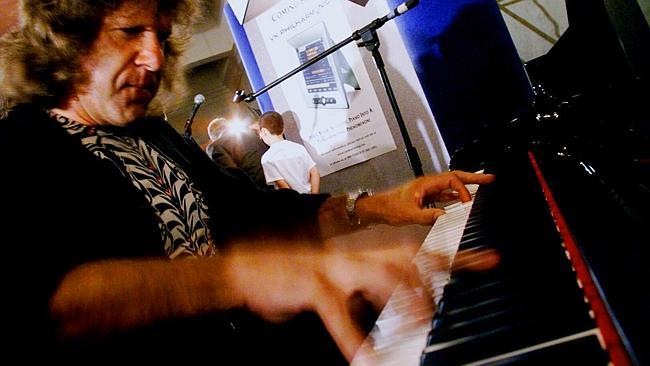Keith Emerson: prog-rocker and keyboards wizard
Playing with his bands the Nice and ELP, he was called the rock keyboard equivalent of Jimi Hendrix.

Combining showmanship, trailblazing technology and virtuoso musicianship, Keith Emerson created a fusion of classical and popular styles that would define “prog rock”.
Playing with his bands the Nice and Emerson, Lake and Palmer, he was called the rock keyboard equivalent of Jimi Hendrix.
While Hendrix set fire to his electric guitar on stage and experimented with gizmos such as the wah-wah pedal, Emerson stabbed his Hammond organ with knives and developed the use of the Moog synthesiser.
On stage, hair flying and his jacket open to the waist, he resembled rock music’s mad professor — stomping between his batteries of keyboards in knee-length snakeskin boots. A huge console with a bewildering array of plugs and wires towered above him.
With the technology still in its infancy, his “Monster Moog” stood 3m tall, weighed 250kg and took four roadies to lift. Emerson also took to riding his smaller Hammond organ “like a bucking bronco” around the stage.
He enhanced the sci-fi effect by creating a “flying piano”, using a special rig to rotate the instrument through the air.
Yet behind the theatrical presentation lay serious artistic intent. With the Nice, he created rock arrangements for pieces by Bach and Tchaikovsky and composed the Five Bridges Suite, which the group recorded with a full orchestra. He also came up with a startlingly off-kilter arrangement of America from Leonard Bernstein’s West Side Story, which he described as “the first ever instrumental protest song”. When he burnt a US flag on stage while playing it at the Royal Albert Hall, he earned the group a lifetime ban from the venue.
With ELP, Emerson went on to rework Janacek and Bartok, record an album-length version of Mussorgsky’s Pictures at an Exhibition suite and reinvent Aaron Copland’s Fanfare for the Common Man with a rock’n’roll shuffle.
“ELP was out on a limb,” Emerson said. “I wanted to create the biggest sound possible, a kind of three-man electric orchestra.”
Even the knife-stabbing had a serious purpose: wedged between the keys of his organ, the blades held down the chord. Initially, he used screwdrivers, until Lemmy — later to find fame with Motorhead, but at the time a roadie for the Nice — gave him a pair of Nazi daggers.
To sniffier classical music critics, Emerson’s rearrangements amounted to desecration. To his detractors in the pop world, his music was overrated.
Indeed, the excesses of ELP were often credited with having single-handedly created punk as a backlash against prog rock’s pomposity. By 1977, no band was more demonised in punk’s roll-call than ELP. Emerson’s street credibility was further compromised when he became a tax exile in the Bahamas, where he kept a boat and spent his time spearfishing and water skiing. Away from music, he was mild-mannered, witty and distinctly non-pompous.
One of his favourite stories concerned a performance of his rock arrangement of Mars from Holst’s Planets Suite: “It was very complex and one section was hard to remember, so I had a monitor set up above the keyboards with the score. I’m playing away and look up, only to see the monitor showing a heavy Swedish porn video.” He immediately suspected a roadie’s prank and took the joke in good humour.
Inevitably, the rock’n’roll, even when given a classical twist, was accompanied by drugs and “rumpy pumpy”, as Emerson describes it in his memoir, Pictures of An Exhibitionist. The book’s hair-raising account of a cocaine binge with Led Zeppelin drummer John Bonham and tales of sharing gymnastically agile groupies made for salacious, if unwholesome, reading.
Throughout his years of enjoying parties on the wild side, he was married to Danish-born Elinor, with whom he had two sons. Aaron became a musician who sometimes played with his father; Damon is a graphic artist.
In 1993, they divorced after 24 years of marriage. Emerson moved out of the family home to live with his new partner, Mari Kawaguchi, in California.
The divorce left him low on funds; he borrowed money to purchase a modest condominium, but continued working and eventually rebuilt his finances. For a while it was doubtful whether he would be able to play again after a condition in his right hand needed an operation on the nerves.
Keith Noel Emerson was born in 1944 in Todmorden, Yorkshire, and grew up on a council estate near Sussex. His father played the accordion in an army band and the family home had a piano, on which Emerson learnt to play. An aunt was a dance teacher and, by the age of 13, he was the pianist at her classes.
On leaving school, he bought a Hammond organ on hire purchase. After playing in various unsuccessful bands, he formed the Nice in 1967.
The next year, he discovered the Moog synthesiser after hearing the composer Wendy Carlos’s electronic recordings in a shop. He asked what it was and was shown the LP’s cover, which featured an early, primitive synth with countless circuit wires coming out of it.
Emerson became perhaps the most famous exponent of the instrument, though when he performed at the Golden Jubilee concert at Buckingham Palace the Queen had to ask him what instrument he played. “I said, ‘Tonight, ma’am, piano, but sometimes I play synthesisers.’ She said, ‘Synthesisers?’ and shrugged her shoulders.”
After the Nice broke up in 1970, he teamed up with bassist and singer Greg Lake and the drummer Carl Palmer to form ELP. The trio announced its arrival in the noisiest possible fashion at the Isle of Wight festival by firing two cannons from the stage.
They had a string of hit albums — Tarkus, Brain Salad Surgery and Trilogy — but disbanded in 1979. There were several reunions and a reincarnation as Emerson, Lake and Powell, with Cozy Powell replacing Carl Palmer.
Emerson loved riding Harley-Davidsons, shooting and flying light aircraft. He obtained his pilot’s licence in 1972 and tried to buy a Spitfire. He fulfilled his ambition to fly one last year.
His body was found by his partner Mari with a self-inflicted gunshot wound. He had been concerned, she said, over a degenerative nerve issue that threatened his ability to play at coming concerts in Japan.
“He was a perfectionist and the thought that he wouldn’t play perfectly made him depressed, nervous and anxious,” she said.
Keith Emerson. Keyboardist. Born Yorkshire, November 2, 1944. Died California, March 10, aged 71.
The Times


